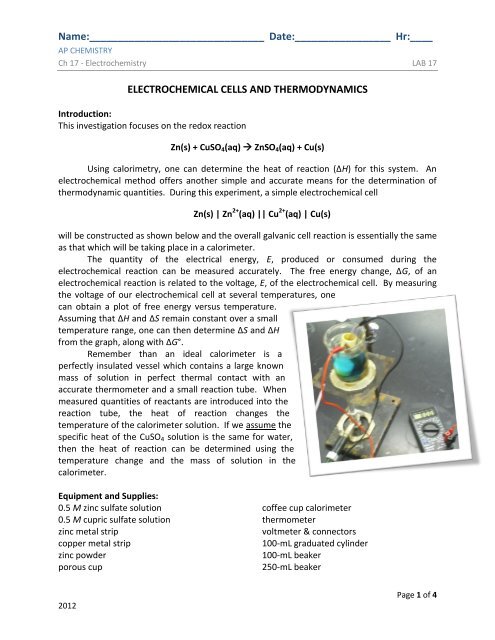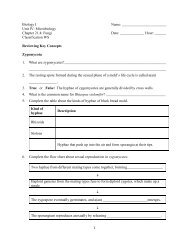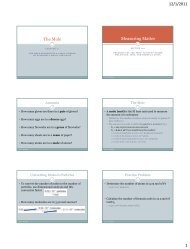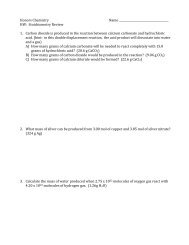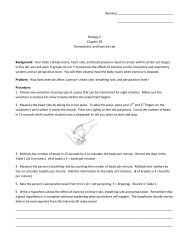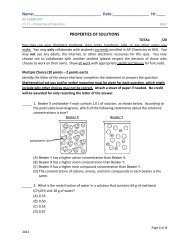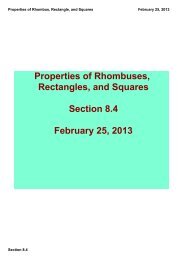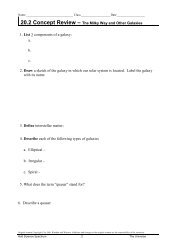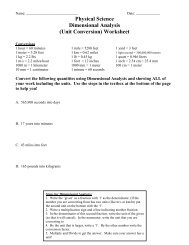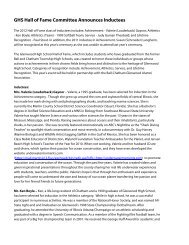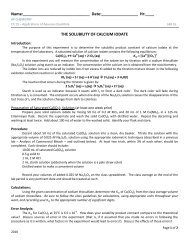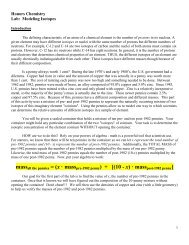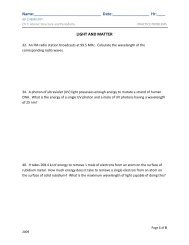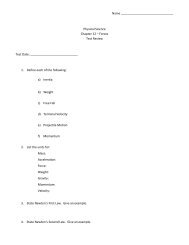Electrochemistry PreLab for THURS 4/4
Electrochemistry PreLab for THURS 4/4
Electrochemistry PreLab for THURS 4/4
You also want an ePaper? Increase the reach of your titles
YUMPU automatically turns print PDFs into web optimized ePapers that Google loves.
Name:_______________________________ Date:_________________ Hr:____<br />
AP CHEMISTRY<br />
Ch 17 - <strong>Electrochemistry</strong> LAB 17<br />
ELECTROCHEMICAL CELLS AND THERMODYNAMICS<br />
Introduction:<br />
This investigation focuses on the redox reaction<br />
Zn(s) + CuSO 4 (aq) ZnSO 4 (aq) + Cu(s)<br />
Using calorimetry, one can determine the heat of reaction (∆H) <strong>for</strong> this system. An<br />
electrochemical method offers another simple and accurate means <strong>for</strong> the determination of<br />
thermodynamic quantities. During this experiment, a simple electrochemical cell<br />
Zn(s) | Zn 2+ (aq) || Cu 2+ (aq) | Cu(s)<br />
will be constructed as shown below and the overall galvanic cell reaction is essentially the same<br />
as that which will be taking place in a calorimeter.<br />
The quantity of the electrical energy, E, produced or consumed during the<br />
electrochemical reaction can be measured accurately. The free energy change, ∆G, of an<br />
electrochemical reaction is related to the voltage, E, of the electrochemical cell. By measuring<br />
the voltage of our electrochemical cell at several temperatures, one<br />
can obtain a plot of free energy versus temperature.<br />
Assuming that ∆H and ∆S remain constant over a small<br />
temperature range, one can then determine ∆S and ∆H<br />
from the graph, along with ∆G°.<br />
Remember than an ideal calorimeter is a<br />
perfectly insulated vessel which contains a large known<br />
mass of solution in perfect thermal contact with an<br />
accurate thermometer and a small reaction tube. When<br />
measured quantities of reactants are introduced into the<br />
reaction tube, the heat of reaction changes the<br />
temperature of the calorimeter solution. If we assume the<br />
specific heat of the CuSO 4 solution is the same <strong>for</strong> water,<br />
then the heat of reaction can be determined using the<br />
temperature change and the mass of solution in the<br />
calorimeter.<br />
Equipment and Supplies:<br />
0.5 M zinc sulfate solution<br />
0.5 M cupric sulfate solution<br />
zinc metal strip<br />
copper metal strip<br />
zinc powder<br />
porous cup<br />
coffee cup calorimeter<br />
thermometer<br />
voltmeter & connectors<br />
100-mL graduated cylinder<br />
100-mL beaker<br />
250-mL beaker<br />
2012<br />
Page 1 of 4
Name:_______________________________ Date:_________________ Hr:____<br />
AP CHEMISTRY<br />
Ch 17 - <strong>Electrochemistry</strong> LAB 17<br />
Procedure:<br />
PART I – <strong>Electrochemistry</strong><br />
1. Pour sufficient 0.5 M ZnSO 4 solution into a clean porous cup to make it about half-full.<br />
Place the porous cup into a clean, dry 100-mL beaker.<br />
2. Pour the 0.5 M CuSO 4 solution into the 100-mL beaker until the level of the CuSO 4<br />
solution in the beaker is slightly above the level of the ZnSO 4 solution in the porous cup.<br />
3. Fold and place a paper towel in the bottom of a 250-mL beaker. Place the 100-mL<br />
beaker into the 250-mL beaker. Add tap water (carefully, so as not to contaminate any<br />
solution) to the 250-mL beaker until the water level is about the same as the level of the<br />
CuSO 4 solution in the 100-mL beaker.<br />
4. Obtain a zinc metal strip and sand it to remove any oxide coating (place the strips on a<br />
paper towel so as to not scratch the lab table). Place it in the ZnSO 4 solution. Repeat<br />
the procedure with the copper metal strip and place it in the CuSO 4 solution. You may<br />
find it handy to bend the top of each metal strip in a “L” near the top of its container.<br />
5. Place the entire assembly on a ring stand. The ring should be adjusted at a sufficient<br />
height <strong>for</strong> heating with a Bunsen burner.<br />
6. Place a thermometer in the 100-mL beaker of the CuSO 4 solution. Support the<br />
thermometer if necessary.<br />
7. With a Bunsen burner, heat the water bath until the thermometer reads above 75°C.<br />
Stop heating.<br />
8. While waiting <strong>for</strong> the thermometer to stop rising, make sure the voltmeter is set to read<br />
in the 2 V range (DCV 2000 m). Attach the alligator clips to the metal strips and observe.<br />
Disconnect one of the wires immediately. If a negative number appears, reverse the<br />
wires.<br />
9. Allow the bath assembly to cool naturally. Read and record 5 or 6 voltage-temperature<br />
readings periodically in the 70-50°C range. COMPLETE THE CIRCUIT ONLY AT THE TIMES<br />
OF READING THE VOLTAGE.<br />
10. Return the solutions to the appropriate waste containers.<br />
PART II – Calorimetry<br />
1. Determine and record the mass of a coffee cup calorimeter. Add about 50 mL of 0.5 M<br />
CuSO 4 solution. Mass the calorimeter a second time.<br />
2. Let the apparatus stand so that the components attain the same temperature. Record<br />
the initial temperature.<br />
3. Using the analytical balance, determine the mass of 0.5-0.6 g of zinc powder as precisely<br />
as you can.<br />
4. Add the zinc powder to the calorimeter. Swirl thoroughly and observe the temperature.<br />
Periodically use the thermometer to break up the copper-coated zinc powder. Record<br />
the maximum constant temperature. Be patient: this is not as rapid a reaction as we<br />
have observed be<strong>for</strong>e in calorimetry.<br />
2012<br />
Page 2 of 4
Name:_______________________________ Date:_________________ Hr:____<br />
AP CHEMISTRY<br />
Ch 17 - <strong>Electrochemistry</strong> LAB 17<br />
Calculations:<br />
Be sure to include an appropriately labeled and referenced graph.<br />
1. Graphically, determine ∆H and ∆S. Calculate ∆G°.<br />
2. Calculate E° from the experimental data.<br />
3. Calculate K at 298K.<br />
4. Determine the ∆H per mole of zinc from your calorimetry data.<br />
Questions:<br />
Discuss the implications of the sign and the magnitude of each of the five experimental<br />
values you determined in this experiment. This discussion should focus on your experimental<br />
values.<br />
Error Analysis:<br />
1. How do your ∆H from the two methods compare (quantitatively)? Discuss possible<br />
reasons <strong>for</strong> any difference.<br />
2. How does your experimental E° compare (quantitatively) to the theoretical value?<br />
Discuss potential sources of errors and their effects on your experimental E°.<br />
Conclusion:<br />
Be sure to summarize the major results of the experiment as you write your conclusion.<br />
2012<br />
Page 3 of 4
Name:_______________________________ Date:_________________ Hr:____<br />
AP CHEMISTRY<br />
Ch 17 - <strong>Electrochemistry</strong> LAB 17<br />
ELECTROCHEMICAL CELLS AND THERMODYNAMICS<br />
Grading Rubric<br />
Item<br />
HEADINGS ON EACH PAGE<br />
Title of Experiment, Date Experiment Started, Successive<br />
Page Numbers, Name & Partner<br />
Points<br />
DATA SHEET<br />
Appropriate Purpose /2<br />
Clear & Complete Procedure /6<br />
Procedure Initialed by Instructor /1<br />
Clear & Complete Data and Observations /5<br />
Data and Observations Initialed by Instructor /1<br />
WRITE UP<br />
Clear & Complete Pertinent Data /2<br />
Clear & Complete Graph Present /8<br />
Clear & Complete Sample Calculations Present<br />
<strong>Electrochemistry</strong> Calculations /8<br />
Calorimetry Calculations /4<br />
Clear & Complete Answers to Questions /5<br />
Clear & Complete Error Analysis<br />
Accuracy of E° /2<br />
Precision of ∆H /2<br />
Clear & Complete Conclusion /4<br />
TOTAL /50<br />
2012<br />
Page 4 of 4


